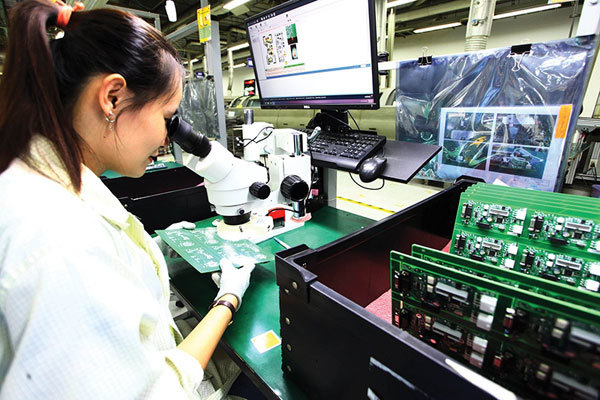 |
| Recent pandemic impacts have put a strain on manufacturers that provide the world with beloved electronics. VIR Photo Le Toan |
Vietnam has four core electronics sectors – computer hardware, components and parts, communication, and audio-visual devices – each with the participation of large international corporations like Canon, Samsung, LG, Panasonic, Intel, and Apple, as well as their suppliers.
Chang Hung Chun, partner at KPMG Vietnam’s Chinese Desk, said that Vietnam also boasts two major electronic clusters. The north is dominated by Samsung, LG, and Foxconn, while the south is home to players like Intel, Toshiba, Nidec, and Jabil – all with export-oriented manufacturing activities.
“Vietnam is home to 2,000 international manufacturers in the electronics industry, employing more than 600,000 people. Last year, the country attracted $30 billion of foreign capital into the electronics sector. Many manufacturers shifted their production from China to Vietnam during the United States’ previous administration, and this trend continues,” he stated.
However, Vietnam and regional electronics bases like Malaysia, Thailand, and the Philippines are experiencing large outbreaks of the coronavirus, forcing a number of manufacturers to lower capacity and suspend operations. It threatens to exacerbate global supply chain issues, especially for products that require semiconductors.
Since late April, Vietnam has reported a record daily increase in COVID-19 infections, most of which have been in Ho Chi Minh City, and the northern provinces of Bac Giang, and Bac Ninh, which are home to electronics facilities.
Samsung has been forced to cut back production at one of its large consumer electronics factories in Ho Chi Minh City after an outbreak sparked the government to find accommodation for thousands of workers at the industrial complex.
According to a person familiar with the matter, the South Korean tech group has been negotiating with the government over the issue.
Taiwanese electronics researcher TrendForce indicated that the recent wave of outbreaks has influenced Samsung’s manufacturing operations. Likewise, the Indian operations of Samsung also fell victim to a huge surge of COVID-19 cases. Samsung’s smartphone production in the second quarter underwent a sharp on-quarter decline of 23.5 per cent to 58.5 million units.
Samsung has been gradually relocating its smartphone production southwards to Vietnam since 2009, mostly to Bac Ninh and Bac Giang.
“Anti-pandemic measures have not affected the internal operations of Samsung’s local facilities, but they have disrupted the supply of components and materials to the facilities. As a result, the capacity of its smartphone production lines fell to around 60 per cent at one time,” said TrendForce.
Meanwhile, Filippo Bortoletti, senior manager of International Business Advisory at Dezan Shira & Associates said, “Vietnam’s electronic industry is exposed to the global chip shortages. Logistics costs are increasing, and shipments are slowing as companies are hunting for chips. Even the cost of semiconductors is increasing. The higher prices for components brought on by the chip shortages are matched with raising prices of electronic devices.”
“Most electronics – mainly smartphones – produced in Vietnam are exported to the US,” Bortoletti said. “However, delays in shipments and increased prices aren’t likely affecting the US market.”
In addition to Samsung, many leading electronic manufacturers may face challenges with expansion plans. South Korea’s LG Display has received an investment certificate to inject another $750 million into its factory in the northern port city of Haiphong, making it one of the largest investments in the first six months of 2021.
Meanwhile, Taiwan’s Foxconn received the green light to put $270 million in a laptop and tablet project with a designed capacity of eight million units per year in the northern province of Bac Giang.
Last October, Goertek’s factory project in the central province of Nghe An’s WHA Industrial Zone 1 (IZ) was also launched. The factory specialises in manufacturing electronic equipment, with an annual capacity of 381 million items.
Taiwanese contract manufacturer Pegatron in March 2020 also received approval for a $19-million facility to manufacture electronic devices in Haiphong. Pegatron’s next project is slated to be initiated in 2021 at a cost of $481 million. Another project is scheduled for 2025-2026 with a budget of $500 million.
According to Bortoletti, the latest outbreak caused a sharp decline in manufacturing industries. As far as electronics are concerned, four IZs in Bac Giang were temporarily closed in May due to the rapid surge of cases. Despite the conditions, however, exports of electronics performed well in the first half of 2021, especially smartphones.
“Vietnam’s electronics industry focuses on mid-stream assembling activities and is heavily reliant on imports such as electronic chips. Therefore, the impact of the latest outbreak on local manufacturers is not as relevant as the upstream disruption due to worsening conditions in other countries,” he added.
Source: VIR

Manufacturing industries face difficulties due to shortage of chips
The shortage of electronic chips is causing difficulties for businesses and electronics manufacturers as chipsets are used in most electronic products and technological devices.

Great opportunity for Vietnam's semiconductor industry
The scarcity of chip supply that began in late 2020 has affected most manufacturing industries.